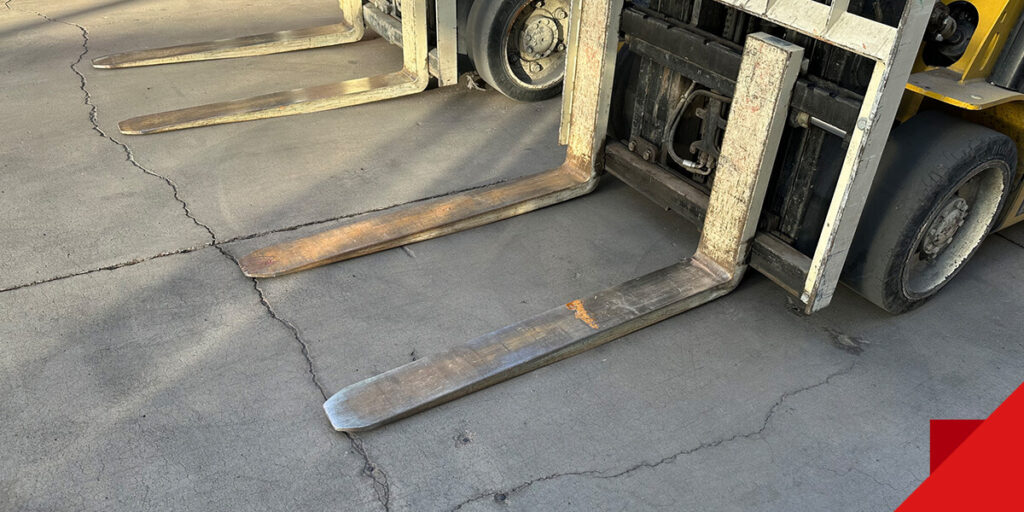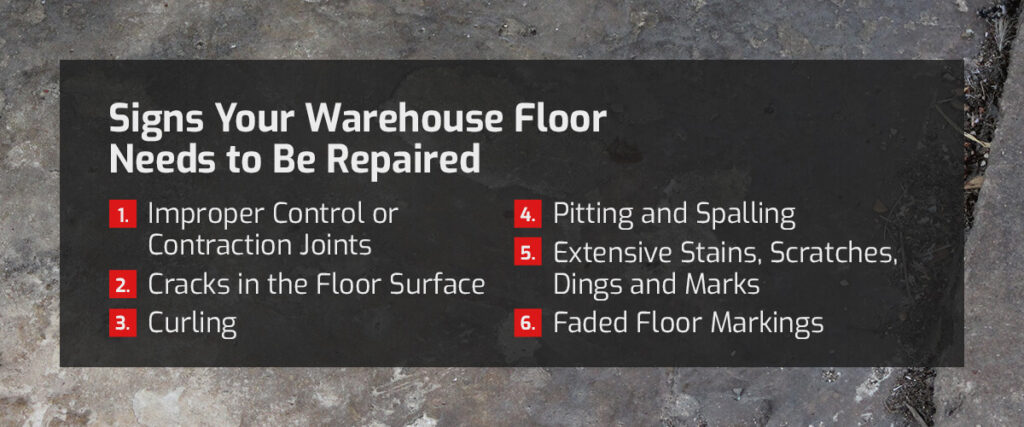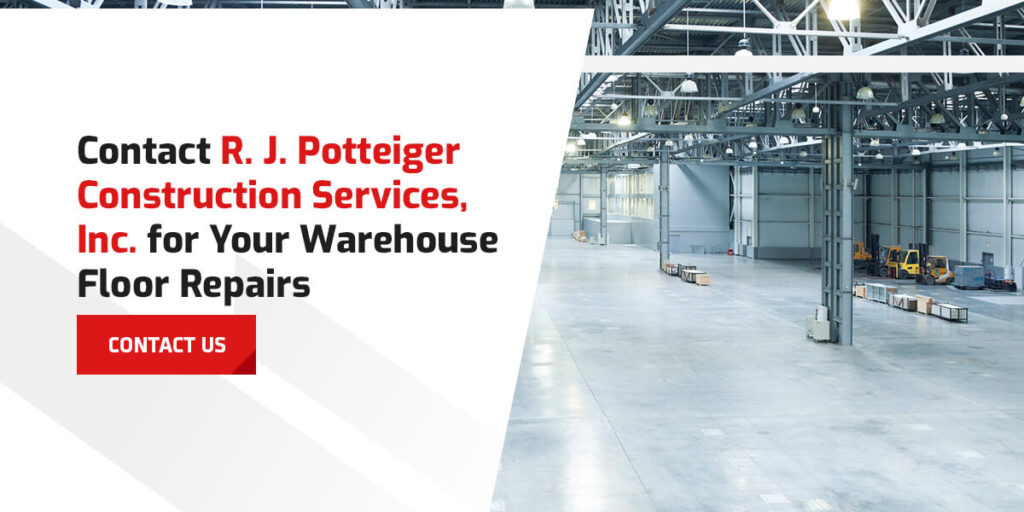SIGNS YOU NEED TO REPAIR YOUR WAREHOUSE FLOOR

Your concrete warehouse floor is subject to heavy foot and machinery traffic on a daily basis, so it is bound to crack under the pressure at some point, especially if it’s old and worn. You might take your warehouse floor’s condition for granted. It’s in plain sight, but it’s also one of those to-do items you tell yourself you’ll check on later and never get around to.
Some signs may indicate the need for your warehouse floor to be repaired. You can also put measures in place to prevent this from happening in the first place. Understanding the importance of maintaining your warehouse floor surface and identifying the signs needing repair can help avoid a complete floor replacement later on.
THE IMPORTANCE OF MAINTAINING YOUR WAREHOUSE FLOOR
Think about the monetary implications of maintaining your warehouse floor. Repairing is more cost-effective than replacing it altogether. Your warehouse floor could be in good condition but concrete cracks may start showing. A professional construction service company can help you to determine the extent of the potential damage.
Concrete warehouse floor specifications and the safety and protection of your employees are as important as saving money on repairs.
Warehouse Floor Specifications
Before construction takes place, the specifications for the warehouse floor should be clear and concise. Consider these basic specifications:
- Appropriate materials used for the base and subbase
- Concrete thickness, determined based on the anticipated load weight requirements
- Materials used in concrete mixture ratios
- Correct concrete reinforcement to control crack width
- Mineral or metallic surface treatment
- Troweling for surface finishing
- Curing to accommodate weather conditions
- Tolerances for all elements in the concrete construction process
- Materials needed to fill joints if required
Though you may be aware of the specifications, it is always good to have a checklist that could help identify any issues you may experience in the flooring at a later stage. For example, failure to follow the correct curing process may lead to shrinkage or cracking. Be involved in the meetings concerning the warehouse floor specifications from the get-go — or at least have an understanding of them.
Discussing Warehouse Safety Hazards
Preventing accidents starts with communication between employers and employees. Having regular open discussions about the hazards involved in their daily work routines creates awareness and aids in keeping workers safe. Illustrate the importance of watching out for trip hazards and communicating any damage to warehouse floors.
Observing Safety Protocols to Protect Workers
A few general safety protocols must be observed to eliminate the risk of accidents while on duty. This includes addressing any safety hazards, like sloped or damaged floors, and implementing preventive maintenance. Maintenance is especially significant where repairing your warehouse floor is concerned.
Adhering to OSHA Requirements
The Occupational Safety and Health Administration (OSHA) reports that trips and falls are common in warehousing, which is why it is important to adhere to safety regulation standards.
Accidents are generally related to the operation of heavy machinery such as forklifts, failure to wear personal protective clothing and equipment and incorrect equipment stacking and packing. The state of your warehouse floor may affect any of these if it is not in an optimal condition for workers and machinery to walk and drive on.
With forklifts, for example, you should do all the necessary inspections and training to make sure the driver and the forklift are in the safest condition to operate. Ensure the floor surface is safe and that no spalling, cracking or holes are present, which could lead to tripping while walking or bumping while driving.
SIGNS YOUR WAREHOUSE FLOOR NEEDS TO BE REPAIRED
Identifying signs leading to your warehouse concrete floor repair helps ensure you enforce the safety standards that are in place. Watch out for the following indicators:

1. Improper Control or Contraction Joints
During the initial concrete floor installation, floor joints known as control or contraction joints are put in the slabs. This small opening permits structural movement in the concrete caused by expanding or contracting during temperature fluctuations. These joints enable sub-surface cracks, thus preventing visible damage caused by cracks on the floor surface. It is vital to know that these were accounted for in the initial floor specification meetings.
2. Cracks in the Floor Surface
Surface cracks are more likely to become visible if there is a lack of contraction joints, or they have parted substantially as a result of consistent traffic and abuse due to wear and tear over the years. Where contraction joints are not spaced properly, shrinkage caused by dryness in the concrete may lead to cracks in the floor surface. Though they may be hairline cracks at first, increased pressure and movement across the vulnerable areas will eventually lead to bigger cracks that require urgent attention.
3. Curling
Curling refers to the rising or curling up of any exposed corners and edges of a concrete floor due to the moisture differences between upper and lower slabs. A sunken center may be noticeable, and the elevated corners may steadily cause cracks to appear as heavy loads impart pressure on them.
4. Pitting and Spalling
Damage caused by pitting and spalling looks different on a surface level, runs deeper and is caused by different effects. Pitting usually looks like the surface has been drilled with a minuscule bit, with tiny holes covering a vast area.
Spalling looks like a blotchy skin rash spreading across the surface, causing thin layers of concrete to crumble or separate. This issue is specifically evident in cold climates, where water is absorbed into the floor and expands and contracts during freeze-thaw cycles. Spalling is also more likely to occur if the floor surface sealing or coating is wearing off.
5. Extensive Stains, Scratches, Dings and Marks
If the floor is covered in stains, marks and dents, it will only get worse over time and inevitably lead to poor floor visibility. Addressing stains and scratches maintains your warehouse’s professional appearance and safety.
6. Faded Floor Markings
Similarly, warehouse floor markings must be clear and visible at all times. They serve as a roadmap for workers who operate heavy machine equipment, demarcating areas where they can and can not access. If markings are faded, accidents are prone to happen, so repainting is always a good idea in this situation.
These are a few of the most common signs that your warehouse floor should undergo repairs to prevent further damage. If you notice any other floor discrepancies, you should consult with a concrete floor repair contractor to explore the possibilities and severity.

LEARN MORE ABOUT OUR WAREHOUSE FLOOR REPAIR SERVICES
R. J. Potteiger Construction Services, Inc. brings you over 30 years of knowledge and experience to deliver concrete services tailored to your needs. Our warehouse repair process is thorough and detailed — we identify the root cause of the issue and apply the appropriate measures and methods to prolong your floor’s life span. If the damage is not too extensive, we can repair it before it needs to be replaced!
To learn more about our warehouse flooring capabilities, visit our Warehouse Floor Repair services page or fill out a contact form online!



